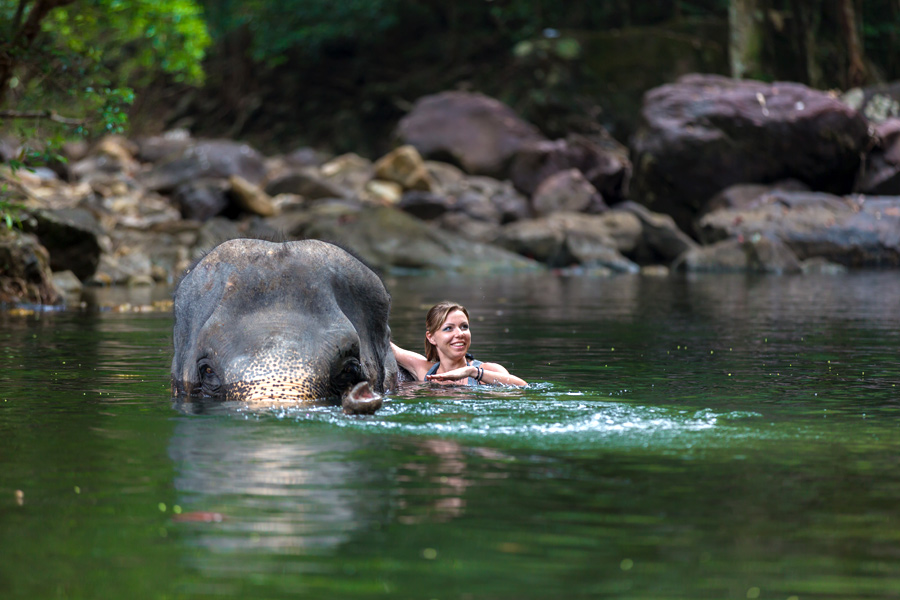[fshow photosetid=72157661677892039]
With many species on our planet threatened if not facing extinction, now is the time to experience Asia’s wildlife in its natural habitat, whether it be pandas in China, elephants in Thailand or Irrawaddy dolphins in Cambodia. There are many trips and locales available; here are a few to get you started.
China’s Pandas and Friends
For a three-day Sichuan panda tour, you can volunteer to work with the pandas at Bifengxia Panda Base in Sichuan province. Working in conjunction with Chengdu Panda Base and Panda Base Ya’an, volunteers work in high hills, surrounded by evergreen forests and old bridges and structures.
Volunteers, who receive a certificate and pin at trip’s end, are able to participate in food preparation, enclosure cleaning and even assisting in medical care and other tasks. Visiting Shangli Old Town and staying overnight in one of the many guesthouses is a nice way to see something different and experience a different side of China.
For a shorter trip (half-day or more) on foot, you can’t beat a walking tour of Tangjiahe National Nature Reserve, located about five hours from central Chengdu. This Qingchuan County reserve, situated on the northwest edge of the Sichuan Basin, is home to a thriving community of pandas.
As China’s second ‘national animal’ (after the dragon, which is, um, harder to spot), pandas are greatly treasured by all Chinese people. Seeing the gentle beasts as they eat and frolic in mountainous bamboo forests is an amazing experience I’d highly suggest you take in.
But, the reserve holds many more species. You can see endangered Takin (wildebeest) on jagged cliffs at high-elevations, as well as golden monkeys and radiant fowl including golden pheasants and multi-hued Chinese Monals.
Get to Mount Huangshan World Heritage Area for walking tours that provide stunning views of the famous “Cloud Dispelling Mountains” of Chinese art fame. The view is, of course, best if you climb the 60,000 steps to the top. You can also see the most over-poached and endangered animal on Earth, the pangolin, which rolls into an impenetrable ball when threatened.
Top Safari in Thailand
Enjoy the peaceful beauty of the Kingdom of Thailand’s northern country with a visit to the Anantara Golden Triangle Elephant Camp & Resort in Chiang Saen, where they have their own herd of elephants that have been rescued from the streets of Thailand.
At the camp you’ll get to learn about, meet and feed the friendly pachyderms and even bathe them. But, the peak experience will, of course, be riding bareback up a mountainside with views of the powerful Mekong River – this, after training to understand commands to give your elephant.
Elephant camps are not uncommon in Thailand but nowhere are the elephants as well taken care of than here where experienced mahouts and staff take care of the gentle giants. Thailand has in the past received some bad publicity due to the sometimes appalling conditions at elephant camps and shows so it is good to see a facility that goes to great lengths to reverse that image.
Come Tour Cambodia
Meandering the beautiful Mekong River can take a lifetime, as can touring through Cambodia’s countryside and jungle. But to sample some of the most amazing wildlife the country has to show, you can simply focus on the Mondulkiri Protected Forest, perhaps the largest protected area system in Southeast Asia.
Hanuman Tours’ five-day excursion, beginning in Pnom Penh, includes visits to native villages, a stop in ‘Spiderville’ or Skuon, where deep fried tarantula is served, and a stop at fascinating Wat Nokor, an 11th century sandstone temple surrounding an updated and lovingly created Buddhist wat.
Along the way, road tripping includes visits to pre-Angkor Wat temple Wat Hanchey and mind-boggling French colonial architecture bastion Chhlong, where you’ll see many of the mansions that give Cambodia her mixed culture charm. More impressive is the visit to Kratie, the port where you’ll begin an offshoot trip in a motorboat, then take paddle boats to see the rare freshwater Irrawaddy dolphin.
Finishing the road, walking and boating trip – which includes going through some areas where tigers have been spotted, though sightings are extremely rare – guests visit Bou Sraa’s double waterfalls, villages of welcoming indigenous Pnong villagers and a local handicrafts outlet.
The part of the safari that ventures into the Elephant Valley Project might be the favourite for many, as it includes a lesson in pachyderm behaviour and body language, then the on-elephant trek through charming Mondulkiri hills to another waterfall, where riders can swim with the elephants and give them a bath.
Safari and Travel Tidbits
- As detailed in a fantastic yet frightening film projected onto the United Nations building in New York City – ‘Racing Extinction,’ created by Ocean Preservation Society (OPS) – as many as half of all species could be extinct by the turn of the century.
- Many of the elephants at Anantara Golden Triangle Elephant Camp & Resort were once street beasts in Bangkok. City life is a tough one, with elephants getting sick from dirty urban conditions and injured in accidents with cars, not to mention abuse from unobserved ‘caretaker’ mahouts. Camp life is great, in comparison.
- Attempt, as best you can, to patronise ecologically sensitive businesses. Good companies partner with World Conservation Society and World Wildlife Fund or other groups that work with them. Conscientious groups also do their best to get supplies from native people and local sources.

